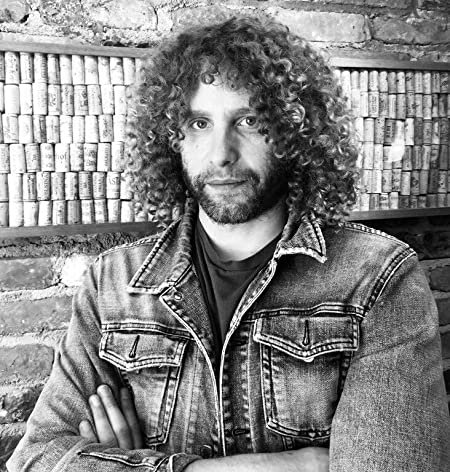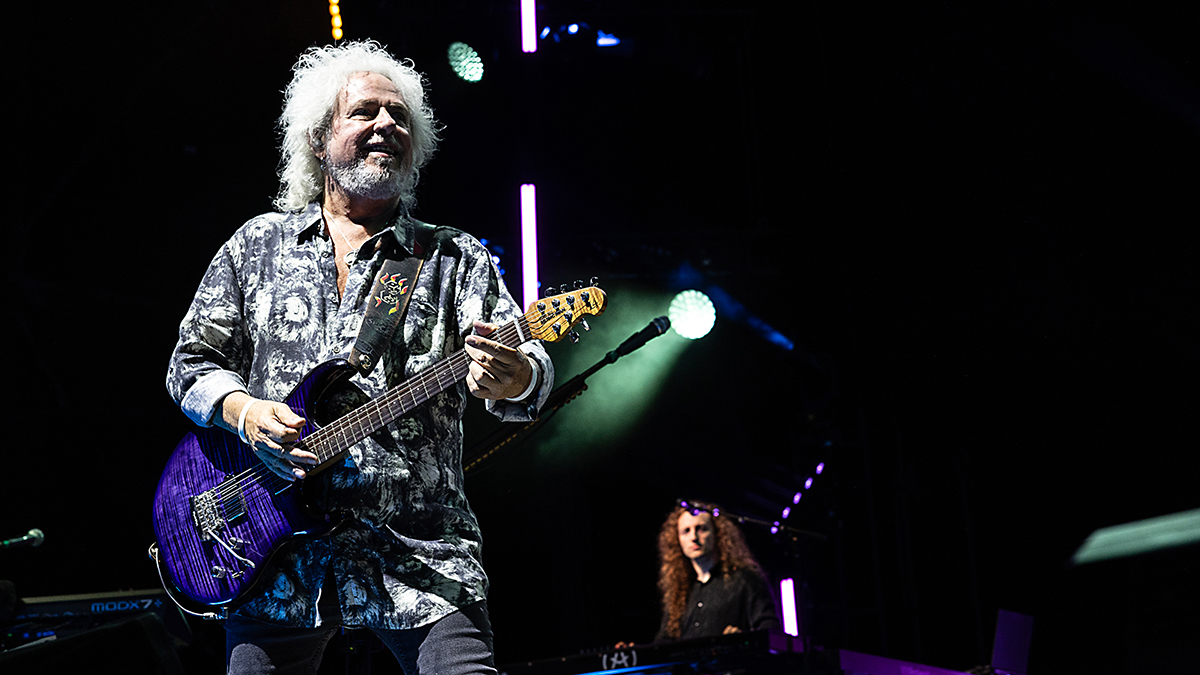Slash Talks Gear, the Guns N’ Roses Experience and His New Album, ‘Living the Dream’
Slash touches on everything from his ferocious new album, to his amazing new Marshall Jubilee and why he enjoys playing 'Chinese Democracy' songs live.

When Guitar World catches up with Slash, The legendary guitarist is far from home — roughly 5,000 miles from Los Angeles, to be more precise, in Tallinn, Estonia, where Guns N’ Roses are playing yet another date on their massively successful 18-month reunion world tour. “It’s my first time here, and its pretty cool,” he says, calling from his hotel room the day after the gig. “They have a big outdoor venue, and there’s an area called Old Town that’s like something out of a nursery rhyme or children’s book. And the show last night was fucking killer.” Next up? Gigs in Norway, Sweden and Iceland (each of them undoubtedly fucking killer in their own right), after which Slash will return to L.A. for what, smart money would assume, will be a much needed, much-deserved break…
Except for one thing: Slash doesn’t take breaks.
“No, that’s just not in my nature,” he says with a laugh. “I can only be dormant for a week or so, and then if I don’t have something planned to do I’ll go crazy.”
Thankfully, he has a lot on tap to keep him busy. Upon returning home, the 53-year-old guitarist will be heading straight into rehearsals with his other project, Slash Featuring Myles Kennedy and the Conspirators. The band will be gearing up for a U.S. tour in support of their new album, a dynamic, high-octane 12-song collection titled Living the Dream.
The record, their third as a unit, finds the band — which includes singer Kennedy (also of Alter Bridge), bassist Todd Kerns, drummer Brent Fitz and rhythm guitarist Frank Sidoris — further refining the sound and style heard on their 2012 debut, Apocalyptic Love, and 2014’s sprawling, 17-track World on Fire. It’s a mix of straightforward, explosive riff-rockers (“Call of the Wild,” “Mind Your Manners,” “Sugar Cane”) and more epic and layered compositions (“The Great Pretender,” “The One You Loved Is Gone,” “Lost Inside the Girl”); further studded with all manner of slight stylistic diversions, from funky, wah-drenched workouts (“Read Between the Lines”) to swaggering, Seventies-style stomp-rock (“Serve You Right”) and hook-filled, soaring anthems (“Boulevard of Broken Hearts” and first single “Driving Rain”).
“There’s definitely a lot going on in this record,” Slash says. “It stays in the hard-rock realm, but it also branches out and just sort of hits the edges of what you would normally expect from us. But this particular little unit is pretty flexible, you know?”
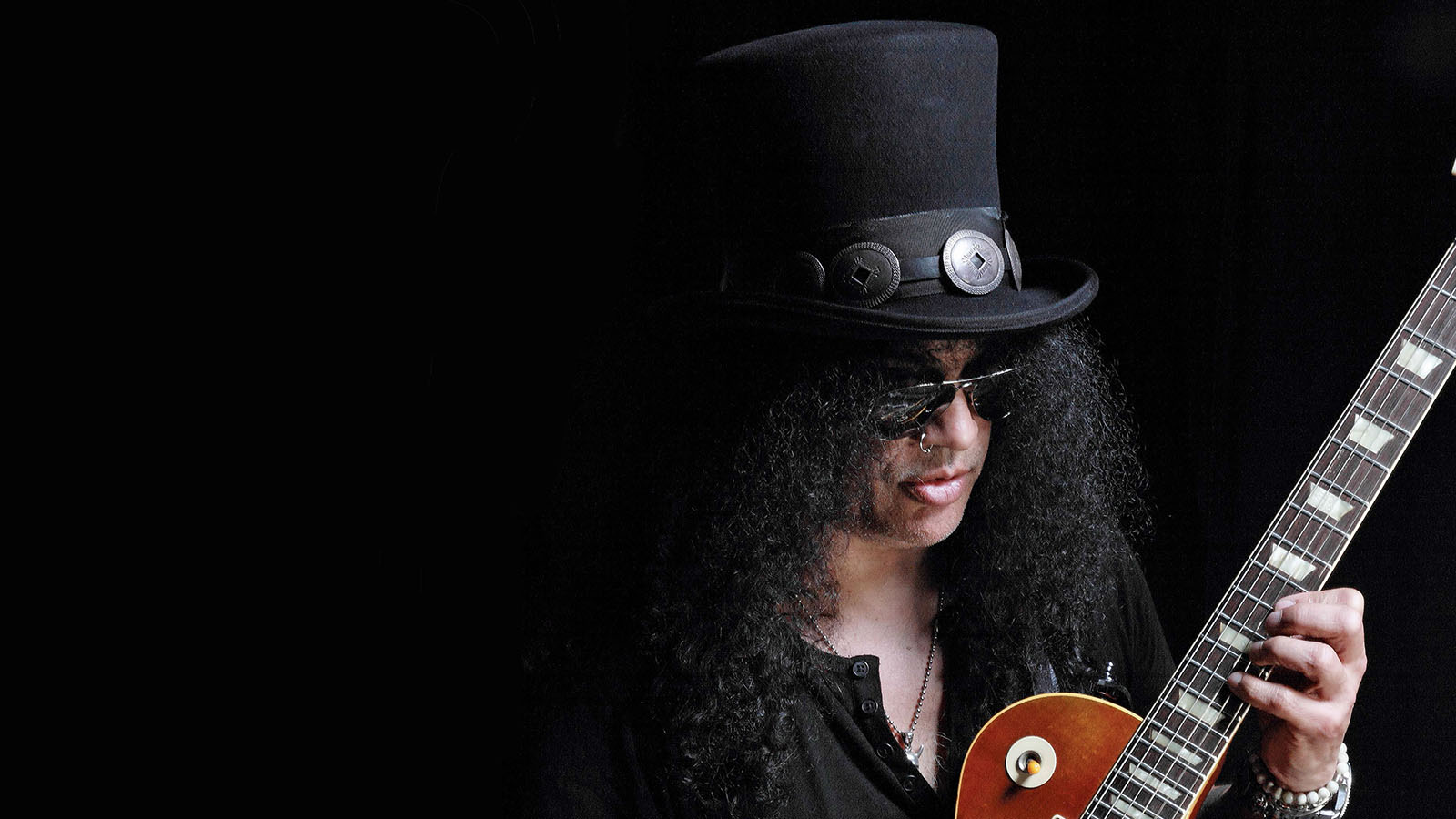
At the core of that unit, of course, is Slash, whose inimitable riffing and distinctive lead guitar work holds the whole thing together no matter how far out the band ventures. More than three decades into his career, the guitarist remains, undoubtably, one of the most instantly recognizable and influential players in all of rock and roll. A fact that has only been reaffirmed these past few years as he has remained in demand, touring extensively and playing to millions of dedicated fans the world over.
All the latest guitar news, interviews, lessons, reviews, deals and more, direct to your inbox!
To that point, due to Slash’s busy schedule with Guns N’ Roses — the reunion sees the guitarist, bassist Duff McKagan and Axl Rose playing together for the first time in more than two decades — the writing period for Living the Dream stretched across several years. Beginning in 2015 during the Conspirators’ World on Fire tour, the band moved forward penning the album in fits and starts before commencing in earnest at the very end of 2017. But despite being a drawn-out process, Slash says he never doubted that the record would get done. “I always knew at some point it was going to happen,” he says. “Because I had no intentions of breaking up the Conspirators to do the Guns N’ Roses thing.”
And indeed, Slash is now ready to move full-speed ahead with his band. “We have the new album, and then the U.S. tour. Then I have another Guns N’ Roses run at the end of the year,” he says. “But after that the Conspirators will do Europe, we’ll do South America, and we’re looking to see if we can do Australia and other places. I love playing with these guys, and so we’re going to play everywhere we can play. We’re definitely going to be busy for a while.”
Which, of course, is just how Slash likes it.
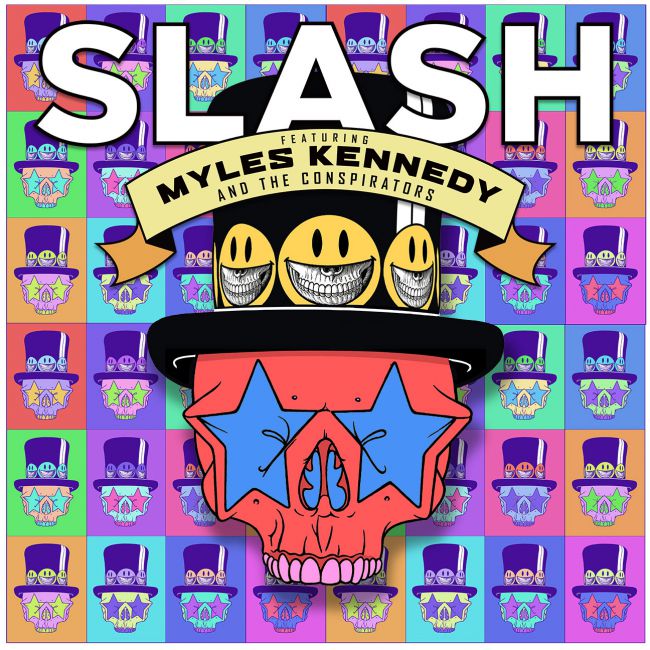
The material on Living the Dream was written over the course of several years. How did everything come together?
We had some songs that we worked on during the World on Fire tour in 2015, like “Serve You Right,” “Lost Inside the Girl” and “Call of the Wild.” “The Great Pretender” was another one. And I was attached to those ideas, so when it came time to really start on this album I definitely wanted to revisit them. But they were in such a skeleton form that it was almost like starting over. Then there was a bunch of stuff I wrote this past January, after one of the legs of the Guns tour was over. A song like “Mind Your Manners” — that was the first thing we played when we started rehearsing at the beginning of this year. I wrote it the second we plugged in at the rehearsal studio, just to have something to jam on. And that turned into a song. So all the material felt pretty fresh. It wasn’t like going back and digging up old arrangements from years ago and doing them exactly the way we’d done them before. Everything was pretty new in its own way.
I recall you telling me once that you compile song ideas by recording them into your phone.
I still do that, yeah. [laughs] Hotel rooms, dressing rooms, buses, wherever. Because I always have my guitar with me on the road, and more often than not I’m just noodling around. So anytime I stumble onto something that sounds cool I put it on the telephone. Because I’ve tried all different kinds of methods of recording stuff, from having a Pro Tools rig on my laptop to, back in the day, just having a Fostex [four track] with me. But those things involve plugging shit in and getting it set up, and there’s always something that doesn’t work just right that you have to fix for a second. And ideas get lost in the time it takes to do that. So the phone is great. You just hit record and go.
Were you coming up with song ideas for Living the Dream while on tour with Guns N’ Roses?
No. I did do some writing, but I was really thinking in terms of Guns at that time. So I have some ideas in my phone that are primarily for that. Because that’s where my head was at. I tend to get into one thing and then focus on that 100 percent. I’m not thinking of anything else. It’s the only way to do it when you’ve got two things that are so all encompassing. You have to shut one off to do the other.
So that means you’re putting together ideas for new Guns N’ Roses material?
Yeah, I think there’s a little bit of that activity going on.
For an album?
There’s talk about doing some recording. I think we all would love to do something that we thought was really cool. We just haven’t really sat down and put our noses to the grindstone to do it. We haven’t really had time. But there’s been a couple things that we’ve dicked around with at soundchecks.
When it came to recording Living the Dream, you did it, for the first time, in your own studio, the Snakepit. What led you to build your own facility?
Well, what happened was, I’ve been using a studio in North Hollywood as a rehearsal space forever. I’ve rehearsed there with Myles and the Conspirators, I’ve rehearsed there with [Slash’s] Snakepit, with Velvet Revolver, even with Guns back in the day. But whenever I’m there with a band, we have to lock it out. And I thought, “God, I would love to have a place where we could just go in and record stuff as we do it, whenever we want…” So a while back I had a couple weeks off and I went looking for properties. And I found this great little place and bought it for really cheap. I gutted it and turned it into a small jam-room-slash-recording-studio. It’s really a comfortable place for us, and it’s tucked away and private. It’s nice to have your own space that’s always set up for you and that has your vibe.
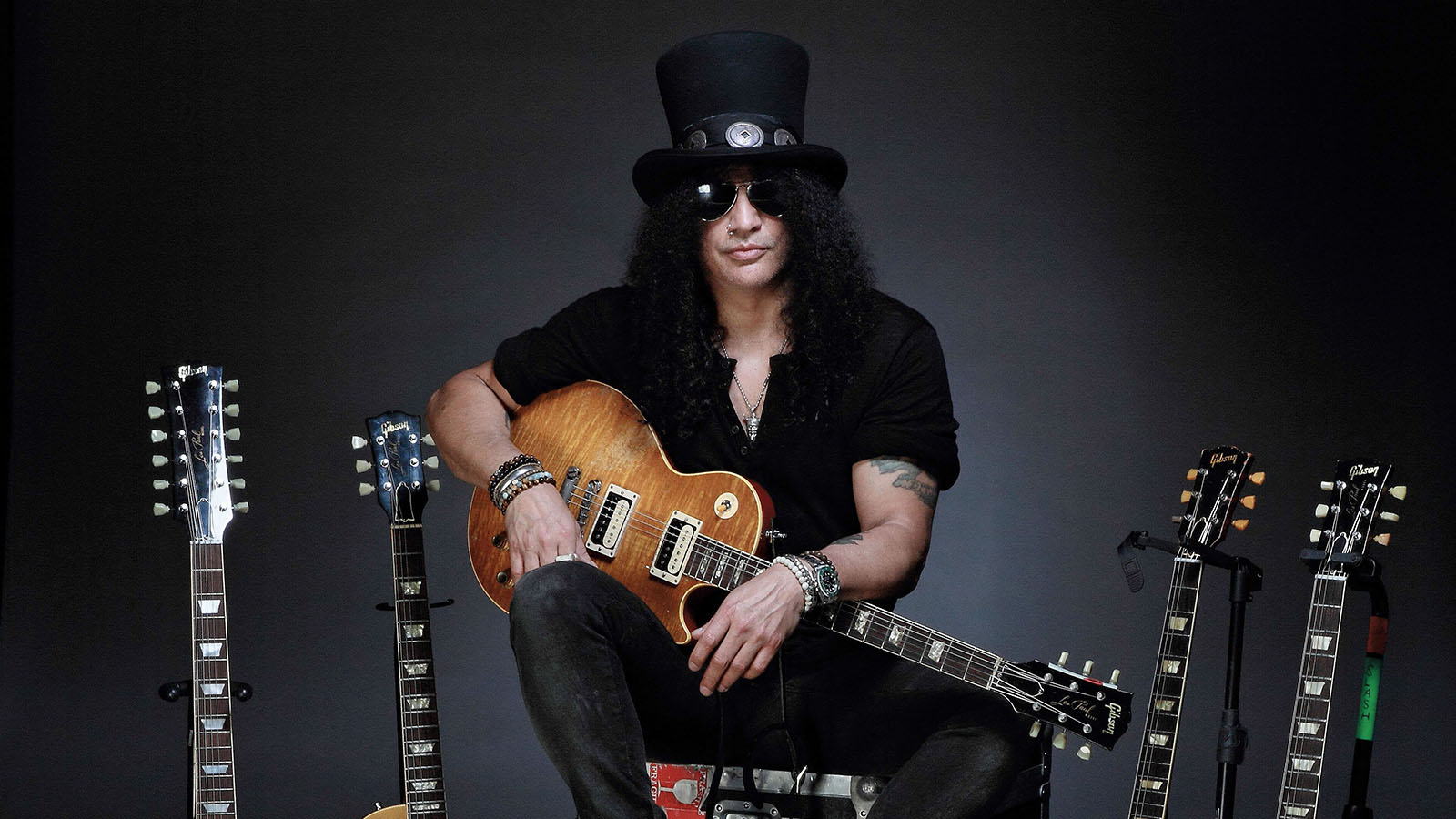
So what’s the vibe at the Snakepit?
I brought in things I like and put up a bunch of photos of guitarists on the walls. A lot of it is Neil Zlozower stuff. There’s a cool picture of Pete Townshend in there. Rory Gallagher. Keith Richards. A great painting of Lemmy. A painting of Ozzy. Some monster-type stuff [laughs]. It was just whatever we could fit in there alongside the gear.
What gear did you use on the new record?
I did pretty much the whole record, with the exception of one song, with a brand-new Marshall Jubilee 100 watt. And what’s funny is, I had found a couple people that had some original Jubilees from the Eighties, and I bought a bunch of them — probably six or seven — because you don’t see them around that often. Then on top of that I have my own Jubilees. But most of those are in the Guns N’ Roses rig. So Marshall actually gave me a brand-new one to use. And it sounded great. So I ended up using only that one and none of mine! [laughs] So that’s the amp on everything. The only song that’s different is “The Great Pretender” — for that one I used an old Fender combo, that belongs to a friend of mine, and combined that with one of my ’59s. They sounded really good together, and it was just so different from the setup for everything else.
What were your main guitars?
I used a ’54 [Gibson Les Paul] Goldtop on a bunch of songs. And then I used my ’58 Les Paul and also my [Kris] Derrig Les Paul [replica]. I also had a ’58 Reissue Tobacco Burst that I picked up from a dealer in London. And that was basically it. Then for the acoustic stuff I used my Martin D-28 that I bought new, back around the time of the Apocalyptic Love record.
You’re obviously a Les Paul guy, but I don’t recall you using a ’54 Goldtop in the past.
I’ve never used it before. Primarily I used it for the song “Call of the Wild,” because that main riff is something I thought might be a little too muddy with humbuckers. And so I said, “Well, maybe soapbars will do the trick…” So I pulled out the Goldtop, and those pickups gave the riff a certain kind of clarity that was needed. And the guitar had such a great tone that I ended up using it a bunch on the record. I used it for “Lost Inside the Girl.” I used it for “The One You Love Is Gone.” I used it for a couple other songs as well. It just has this great scream to it.
How about effects?
There’s not really much of anything. I used an old MXR Phase 90 on “Slow Grind,” and there’s maybe some chorus on a few things. Otherwise it’s just wah. Two wahs, actually. One was my signature [Dunlop Slash Cry Baby Wah] and the other was a standard Cry Baby that’s been in my arsenal for god knows how long. My wah tends to be very thick and midrange-y, which is fine. But there was one song, I think it was “Read Between the Lines,” where I wanted something a little bit more old-fashioned, so I used the old Cry Baby.
“Read Between the Lines” has wah all over that main riff, and it’s in a funkier style for you guys. How did that one come together?
Okay, there’s two different thoughts on the origin of that song. My memory is of playing it for the band, and then Myles coming in and not being too enthusiastic about it. He said, “You know, maybe that would make a good instrumental…” [laughs]
That’s sort of a gentle way to make your feelings known.
Yeah, exactly! And I was like, “I don’t wanna do a fuckin’ instrumental!” This was a few years ago. But fast-forward to 2018, and Todd, Brent and I were in the rehearsal studio banging the stuff out to get ready to record. And I sent a tape to Myles and I said, “This is that song you didn’t necessarily go for, but I’m just telling you to try and come up with something because I think it’s really cool.” And Myles got back to me and he said, “No, I love this! I never said I didn’t like this!” And I was like, “Huh… I have a very distinct other memory of it!” [laughs] But what he came up with was so great. So it ended up working out.
You mentioned earlier that “Mind Your Manners” is a song that came together on the spot in the rehearsal room. It’s such a great, high-energy riff-rocker. It really captures that spontaneity and immediacy.
Yeah. I mean, sometimes you just have to not to overthink it. Don’t let yourself get inhibited by trying to be musically fucking profound or anything. Just do it as spontaneously as possible. Get to the next chord changes. It doesn’t matter if it’s a I-IV-V. Do it because it feels good!
Then there’s a song like “The Great Pretender,” which sounds considerably more composed. In particular, that great single-note guitar theme, which is a very “Slash” type of part. It’s reminiscent of your melodies in Guns N’ Roses songs like “Sweet Child O’ Mine” and “Estranged,” or Conspirators tracks like “Anastasia,” from Apocalyptic Love, and “Iris of the Storm” from World on Fire. Where does that type of thing come from?
Well, with “The Great Pretender,” it was something that just happened. I don’t even remember exactly what brought that on. I know it came to me in a hotel room somewhere on the World on Fire tour. But I don’t remember the catalyst. I just know it was a very unorthodox kind of a riff, and I brought it to the guys at a soundcheck and we were trying to find the right drum groove for it. That was always the biggest thing, trying to find the right drum pattern to give it the right feel. I didn’t want it to be too jazzy and I didn’t want it to be a big rock ballad. And that was the stickler for that song. But it all fell into place.
As for the guitar theme, that’s a good question! I’m trying to think of some melodic guitar thing I could equate that to. I mean, I’ve always obviously looked at guitar solos as being really important to the song as far as melody is concerned. But as far as having a single guitar line being the root of the song, nothing comes to mind that I modeled that after. But I’m sure there’s a few of them!
Your rhythm guitarist, Frank Sidoris, has been part of the Conspirators live band for a few years. But Living the Dream is the first record he appears on with you. What was it like to have him in the studio with the rest of the band?
It was great. I auditioned a healthy chunk of guitarists before Frank, but when he came in it just felt really, really natural. So over the course of the World on Fire tour I started to think that it would be cool to have him on the next record. So when the time came, he came in and just started working. And you know, the way I’ve always worked with other guitar players is, “This is how it goes…” And then they just come up with your own thing. [laughs] That’s basically how I do it. And Frank just fell in really effortlessly. I was super, super impressed with him in the studio. He was just unbelievably together. He did an amazing job.
Does this record feel like a progression to you, in relation to what the Conspirators have done in the past?
I definitely think there’s a progression, but I don’t necessarily think there’s a recognizable directional shift, at least not consciously. But looking back at it, it’s definitely a diverse record as far as feels and things like that. But I think a lot of that has to do with the fact that whatever it is I might come up with, Myles is great at coming up with something that fits it. So we can really go anywhere we want, depending on how far left field we want the band to sound at the end of the day.
With all the Guns N’ Roses activity that has been going on over the last two years, did you ever wonder whether you would get back to the Conspirators?
No. It was something I had said early on when the Guns thing first started: At some point I’m going to go back and do this Conspirators thing. So it was just a matter of finding that window. And with Guns, we just kept attaching more and more dates as we went, so it wasn’t until this past December where I saw that window. But once it was there I said, “That’s where I’m gonna do this.”
Over the past decades there’d been so much talk about a Guns N’ Roses reunion — not really from you or other band members, but rather from the press and the fans. When it actually came to fruition, I imagine you were just as surprised as the rest of us.
Well, really, I had no foresight of a reunion whatsoever. The most important thing to me was that Axl and I got together and managed to have some lengthy conversations about stuff that concerned us. Just to have that sort of relationship back and that camaraderie between the two of us, band stuff aside, was really important. I was really relieved to have that. Because some of that negativity that had built up over the years, especially by the media, just turned into something that you’re carrying around all the time. It was sort of like the elephant in the room. So it was good to get rid of that. Then when the conversation turned to [headlining] Coachella, it just sounded like a really fun thing to do. But I don’t think any of us really foresaw it going as long as it ended up going. But all things considered, it was just a testament to how much fun the whole thing was.
Your first time back onstage with the band was at the Troubadour in April 2016. How surreal of an experience was it to walk out there with Axl and Duff as Guns N’ Roses and kick into that first song?
Actually, the first song of the show wasn’t as surreal as showing up there for soundcheck. That was, I think, the real surreal moment. But at the same time, one of the interesting things about reuniting with Guns is that it doesn’t remind me of anything from the past. There’s not flashbacks, like, “I was standing here at this time 20 years ago…” or some bullshit like that. I just look over and I see two guys I’ve known for 30 years. There is that familiarity, and there’s a familiarity with the songs, but it all seems very new.
But that said, I have to say that that moment I got onstage at soundcheck at the Troubadour it was sort of like a time-lapse camera that went all the way back to 1985. [laughs]
One of the things that’s been a nice surprise at the Guns N’ Roses shows is to hear you playing songs from Chinese Democracy.
Yeah. You know, it’s very different… it’s really cool stuff, but it was played by guitar players that are very different from me style-wise. I’ve sort of adapted my own way of playing those songs to where I feel comfortable with them, but without losing the integrity of how the guitar parts go. So it’s been a lot of fun to do, like, the song “Chinese Democracy,” which I love playing. And there’s a song we’ve been playing lately called “Madagascar,” which, I don’t even know exactly what the guitar parts are on the original at this point because I’ve changed it so much. [laughs]
That said, I also want to give credit where credit’s due — the guitar players that played on Chinese Democracy, Buckethead being one of the main ones — are fucking amazing guitar players. I have to give those guys a shout-out because that stuff was cool. Very different from what I normally do. So it’s been interesting learning some of the stuff that was on that record. I definitely had to figure out ways to adapt to it.
As far as the Conspirators go, there has always been a healthy amount of Guns N’ Roses material in your live shows. Will that change now that you’re actually out there playing those songs again with Guns N’ Roses?
Yeah, definitely. The thing about doing Guns N’ Roses material with the Conspirators is it was just fun for me to do because I hadn’t done it in so long. And even as we built up more of our own material we kept doing it because it’d become part of the gig, you know? I think people had come to expect it. But at this point, after touring for this long with Guns N’ Roses and knowing it’s going to continue on indefinitely, when we go out to support this new record I plan on leaning more on all the Conspirators material. I haven’t sat down yet and really started focusing on what we’re going to do and what we’re not going to do, but that’s the plan. I don’t have any need to do all the Guns stuff anymore. Because I’m doing it.
What do you like about playing with the Conspirators?
The connection is just something that happened from the get-go. And you know, it started out with my name on the marquee, and then it said, “featuring Myles Kennedy.” But once we did the Apocalyptic Love record it was like, “I don’t want to necessarily go about changing what we’ve already established up to this point, but it feels more like a band…” So we came up with the Conspirators and just put the whole idea together. So it’s led by me, and I sort of direct the ship and pretty much write all the music. But at the same time I very much treat the whole thing as a band. We just have this natural relationship of it being very band-like. There’s been a very comfortable, magic kind of feel from the very beginning. I like playing with them because that exists.
Given that, I would assume, in your mind at least, it won’t be another four years before we get another Conspirators record.
No. I think we’ll find some sort of comfortable rhythm. We’ll figure it out as we go. [laughs] Just like we always do.
Rich is the co-author of the best-selling Nöthin' But a Good Time: The Uncensored History of the '80s Hard Rock Explosion. He is also a recording and performing musician, and a former editor of Guitar World magazine and executive editor of Guitar Aficionado magazine. He has authored several additional books, among them Kurt Cobain: Montage of Heck, the companion to the documentary of the same name.
